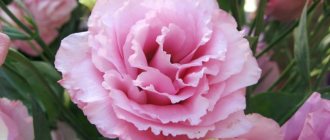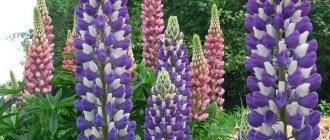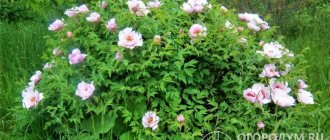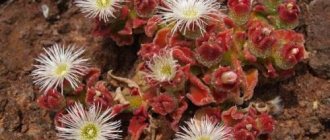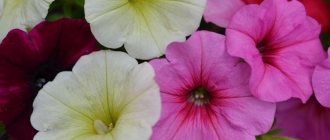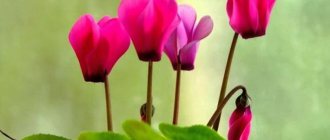Date canarian also called Canary date palm (Phoenix canariensis). This plant belongs to the date genus and the palm family (Palmaceae). In nature, they can be found in rocky areas of the Canary Islands.
This palm tree is quite large. So, it can reach a height of 18 meters, while the width of its trunk will be equal to 1 meter. The unbranched straight trunk is quite strong. On its surface there are many stumps, which are the remains of dead and fallen leaves. The leaves are found only at the top of the palm tree, and there are from 150 to 200 of them. Short-petioled leaves can reach from 4 to 6 meters in length. The greenish-gray, compound-pinnate leaves consist of hard, narrow leaves, of which there are from 80 to 100 pieces.
The flowers are divided into female (yellow-orange) and male (cream). They are collected in fairly large branched axillary inflorescences, while the female inflorescences can reach 200 centimeters in length. Small (about 2 centimeters in length) oval-shaped fruits are orange in color. Each fruit contains one large seed.
Botanical features of the Canary date palm
The Canary Islands are considered the birthplace of the Canary date palm. In their natural environment, the trees grow in the humid forests of South Asia and Africa.
Today, the Canary date, or Luxor, is found in all regions with tropical and subtropical climates.
Under natural conditions, a palm tree grows on average from 15 to 25 m. A date tree grown in a greenhouse or at home will reach a height of 1.5-2 m.
The trunk of the perennial palm is straight, with multiple scars remaining after shedding the leaf blades. The crown is lush, concentrated at the top of the tree.
Each leaf blade contains up to 150 sharp, narrow leaves of silver-green shades. The length of the leaf blade of an adult tree reaches 6 m. In adult trees, long, sharp thorns are formed in the lower part of the leaf cover.
During the flowering period, inflorescences appear on the tree, male, cream-colored, and large female, yellow and orange flowers.
In place of the flowers, small, sweet and fleshy fruits of orange shades are formed, each of which contains a large seed.
Interesting! African tribes still use large palm leaves to cover the roofs of houses to this day.
How and where do dates grow?
Any schoolchild knows what tree dates grow on. This is the date palm or palmate date (Phoenix dactylifera). The homeland of dates is the coast of Africa from the Mediterranean Sea, the Middle East and the Arabian Peninsula. The date palm has been cultivated by people for 4,000 years and has spread very widely during this time. The palmate date thrives in countries with dry, hot climates and is an inhabitant of the dry tropics.
Of the European countries, only Spain can boast of growing palm trees, where the Sayer variety is acclimatized. In our country there are no suitable climatic conditions to grow palmate dates. The palm tree is found in Sochi, but does not bear fruit, but only decorates city streets and squares.
Knowing in which natural zone dates grow, Soviet scientists in 1939 planted a plantation of date palms near the city of Etrek in the south of Turkmenistan on the border with Iran. Dates in Russia (then the USSR) successfully took root and began to bear fruit. But the country fell apart, and with it the experimental station and tropical culture disappeared. Now in Turkmenistan there is talk about its revival. But knowing how many years it takes to grow a palmate date, you will have to wait a long time for “your” dates: the lifespan of the plant is 150-200 years, and fruiting of a small palm tree begins in the 15th year.
The date palm has many interesting features:
- reaches a height of 25-40 m (but dwarf specimens are also found);
- the columnar trunk is lumpy due to dead leaves;
- the complex pinnate leaves of the date resemble fans, they are hard with spiny tips;
- the plant is dioecious: male and female flowers are formed on different plants;
- female flowers are inconspicuous, while male flowers form cascades of cream and yellow inflorescences;
- in November, palm trees bloom and 10 months later, in August, the fruits ripen.
Advantages and characteristics of the plant
The main advantage of the Canary date palm is its ease of care. With good lighting and timely watering, the tree grows and develops quickly.
The Canary date takes root well and purifies indoor air from the negative effects of the environment.
Exotic crops are grown in winter gardens, greenhouses, greenhouses, loggias and indoors. At home, a well-lit, free space is chosen for the date palm.
Date Canary - a living palm tree for home and office
Do you want to have a real live palm tree at home? Then hurry up to buy a beautiful plant with a fully formed crown and varying degrees of growth - Date Canary. It belongs to the Arecaceae family and has a short, columnar trunk, as well as bluish-green carved leaves that make this palm light and airy. Its flowers are collected in large inflorescences, the male inflorescences are cream-colored, and the female inflorescences are orange-yellow, the latter can reach up to 2 meters. Its fruits are small, orange in color and oval in shape.
Little advice
. If you decide to purchase this plant, then do not do it in winter. With a sudden change in climate (when moving a date from a store to the street, then into the house), the plant may lose all its leaves.
Date Canary care at home
In the premises where the Date of Canaries is located, a cheerful atmosphere, comfort and harmony always reigns. This type of palm tree, like the Robelena
cleans the air well
from toxins and dust, moisturizes it and creates a comfortable microclimate. This has a positive effect on the well-being and mood of office workers or residents. By the way, the Canary date gets along well in any conditions. The main thing it needs is a bright room and regular watering.
If you decide to buy a Date Canary, think about where to place it
.
This plant is quite large and very beautiful. It will look spectacular in bright and spacious living rooms, offices, conference rooms or hallways. In general, Date Canary is suitable even for balconies and loggias. To ensure that the crown of the date develops evenly, turn it occasionally. It easily withstands temperatures
from 10 to 18 degrees, and also grows well in indoor conditions.
watered
immediately after the top layer of soil has dried. Ideally, it needs moist air and a temperature of 20 - 25 degrees.
To make care easier and grow a beautiful and healthy plant, you can buy a pot with automatic watering
. The Canary date in combination with a flowerpot will always be the center of everyone’s attention and will make any room harmonious and cozy. An adult palm tree reaches a height of 140 cm, so it is better to place it on the floor closer to the wall or in the corner of the room. In offices or shopping centers, palm trees are often installed in recreation areas, near fountains or benches.
Pests and diseases
The Canarian date palm can be affected by scale insects, scale insects and spider mites. If pests are detected, immediately treat the plant with appropriate chemicals.
Variety varieties
Luxor, a variety of the Canarian date palm, adapted for indoor cultivation. The tree is distinguished by its compactness; with proper care, it grows from 1.5 to 2 m. The crown is lush, branched, with many large, feathery leaves of bright green shades.
The miniature palm tree is used for landscaping apartments, houses and office premises.
Important! The Luxor palm grows lush and beautiful only under conditions of good sunlight and high humidity.
1.Seven secrets of success:
| 1. Growing temperature: during the period of active growth and budding, the date palm is kept at normal room temperature, in the fall the temperature is lowered and in winter a cool dormant period is provided at a temperature of 13 - 15 ° C. |
| 2. Lighting: The date palm should be bathed in sunlight for 2 to 4 hours daily - morning and evening. In autumn and winter, provide maximum lighting. |
| 3. Watering and air humidity: water the plants in spring and summer in such a way that the top layer of substrate 2 - 4 cm thick dries out between waterings. In autumn and winter, the frequency of watering is reduced in accordance with the room temperature. Air humidity is high. |
| 4. Pruning: sanitary - cut off old and diseased leaves at the base of the palm tree crown. |
| 5. Soil: well-drained and nutritious soil with a sufficient content of coarse river sand and a neutral or slightly acidic pH. |
| 6. Feeding: in spring and summer, fertilizing should be regular - every 2 weeks, with mineral fertilizers for palm trees or ornamental foliage plants; in autumn and winter, plants should not be fed, allowing them a period of rest. |
| 7. Reproduction: by sowing seeds in spring in a loose, nutritious substrate, the Robelena date is propagated by cuttings. |
Botanical name: Phoenix.
Family
Homeland of the plant. Africa, Canary Islands.
How it grows. The date palm is a genus consisting of 17 powerful palm trees with a thick trunk and an elegant, spreading, airy crown.
The trunk is covered with brown petioles of dead leaves.
The green leaves have a curved shape and consist of many narrow, pointed segments.
Under the crown in the warm season, large, drooping, branched inflorescences appear, formed by many small orange or yellow flowers.
Palm fruits are known to everyone, edible and very pleasant to the taste. For pollination and fruit formation, 2 trees must be located nearby - male and female.
Height. In the natural environment, the height of plants reaches 20 - 30 m. Young palm trees are kept indoors.
These plants develop very slowly and in indoor culture often do not exceed 120 - 140 cm.
What you will need
Before planting the Canary date palm, stock up on fresh seeds and patience. After all, the period of germination of seeds of an exotic tree will take from 2 to 4 months.
Container and drainage
Palm rhizomes develop in depth, so deep and tall pots are chosen for planting.
See also
The benefits and harms of kiwi for the body, how to eat the fruit and contraindications
Read
At the bottom of the container in which Luxor is planned to be planted, lay a thick drainage layer of small stone, crushed stone or pebbles.
Stagnation of water in the pot will lead to rotting of the root system and death of the tree.
Required soil composition
Soil for planting date seeds can be purchased from flower shops or prepared independently.
To do this, mix peat, compost, light, turf soil, charcoal and sand. A little organic matter is added to the finished mixture.
If it is not possible to prepare the soil yourself, buy universal soil for growing flowers in the store.
How to grow a flower and what care does it need?
Date palms at home grow slowly and require high-quality care. To ensure normal development of the plant, the following conditions must be observed:
- Bright lighting . As soon as the seedling produces feathery leaves, it is necessary to provide it with as much light as possible - for example, take it out to the balcony if it is summer outside, and organize artificial light in the cold season.
- Correct location to the light . If side light falls on the palm tree, the pot should be rotated regularly.
- Drainage of pot and soil . A palm tree that is not young or mature cannot tolerate stagnation of water in the root zone.
- Abundant watering . Date is a water-loving plant; the soil clod should not be allowed to dry out. Insufficient watering leads to drooping leaves and death of the palm tree.
- Warm content . Growing palm trees like warm temperatures and react negatively to extreme temperature fluctuations. For them, both good lighting and a temperature optimum of at least 15 degrees Celsius are equally important.
- Timely transplant . Young dates must be replanted every year until they reach the age of five.
- Careful attitude towards the top of the palm tree - the growth point . Due to mechanical injuries, rotting or drying of young upper leaves, the palm tree dies within a year.
Proper watering and spraying
Watering is carried out depending on the time of year. In summer, it is very important to prevent the soil from drying out, so water the plant abundantly and every day . In winter, before watering, you need to check the top layer of the substrate, and water the palm tree only if the layer has dried well.
Article on the topic: Growing geraniums from seeds at home. Growing pelargonium from seeds How to plant pelargonium from seeds
It is also not recommended to overwater the plant - the tips of the fronds of date palm leaves may turn black from excess moisture.
Date palms love air with a humidity of 40-50%. For this reason, in the summer you should spray the palm tree from a spray bottle with settled water at room temperature. In winter, this procedure can not be carried out. But it is also recommended to wipe the palm leaves with a damp cloth from time to time.
Fertilizer and feeding
It is necessary to fertilize a palm tree growing at home before the active period of development - in early spring. It is enough to add special mixtures once a week. Vegetation will become a powerful basis for the development of underground and above-ground parts.
The date tree loves fertilizers with the right composition. You can add both organic matter and minerals to the soil, and also alternate them harmoniously.
The following fertilizers are used to feed date palms at home:
- Bird droppings.
- Fertilizer for palm trees.
- Potassium nitrate.
- Humus.
- Dry organic matter.
- Mineral complex.
It is best to alternate different types of feeding, this is how the growth and development of the plant is best stimulated.
What kind of soil and pot do you need?
The ideal soil for dates is breathable, well-permeable soil with plenty of nutrients.
Special soil for palm trees can be purchased at flower shops and florists; universal soil for indoor plants is also suitable. You can make your own composition for homemade palm trees using three ingredients in equal parts:
- Sod land.
- Sand.
- Humus or compost.
Article on the topic: Do-it-yourself maintenance of unilos astra. Astra septic tank maintenance
You can add a tablespoon of superphosphate to the prepared soil for every 3 liters of mixture.
Another soil option:
- 2 parts of turfy, leafy soil.
- 1 part peat and sand each.
- A handful of coal.
Since the date must be replanted every year in the first five years, the pot must be selected according to size - first choose a small one and gradually increase its size. It is unacceptable to immediately plant the plant in a large pot - this is one of the most common mistakes in growing dates at home.
Trimming
Pruning should be done regularly as dead leaves, broken leaves, and leaves that bend below the horizontal appear. Additional shoots of the P. Reclinata date palm must be removed to prevent the main trunk from stunting. When pruning, be careful not to damage the main shoot of the tree .
Leaves that have changed color from green to brown or yellow should not be removed. In this situation, you should address the cause of the problem - a lack of nutrients in the soil.
Temperature and lighting
Date is a light-loving and heat-loving plant , therefore, the more light and heat it receives, the better. In summer, it is best to take the plant out into the air - put it on a balcony or keep it on a windowsill with an open window. In winter, the room temperature should not be allowed to fall below 15 degrees. When indoor humidity is low, provide the plant with diffused light - sunlight can cause yellow and brown spots to appear.
Article on the topic: From the history of the invention of concrete. Construction of concrete floor coverings Technology of using slabs in road construction
In winter or if the windows face north, you should think about purchasing and installing special phytolamps. The lamps must be installed strictly according to the instructions, at a distance, so that the palm tree does not get burned.
Selecting and preparing seeds for planting
The main condition when choosing planting material is that the palm seeds are not subjected to heat treatment.
The seeds can simply be planted in fertile soil and wait 5-6 months for the first shoots to appear. But to speed up the process of germinating date seeds, you will have to do the following:
- Date pits are thoroughly cleaned and washed, then dried.
- Before soaking, the seeds are scalded with boiling water or small cuts are made on them. Such measures will allow moisture to quickly get inside the planting seed.
- To soak a date pit, you will need any natural fabric or cotton wool.
- The seeds are wrapped in material and thoroughly moistened.
- The container with the seeds wrapped in a wet cloth is placed in a warm place.
- Until the bone swells, constant hydration is maintained.
- As soon as the seeds have increased in volume, they are transplanted into fertile soil.
Important! For germination, prepare a few date pits. After all, plants tend to get sick and die if transplants are unsuccessful, so in order to grow a healthy and beautiful tree, it is better to play it safe.
Growing dates from seeds
Hamerops care at home, photos, growing from seeds, reproduction
Many plant lovers have experience growing dates from pits. The correct choice of soil, pre-sowing treatment of the material, and compliance with growing conditions are of great importance. Growing dates from pits is a long process, which averages 3 months.
Selecting a seed to plant
Seeds for planting are taken only from those fruits that have not been subjected to heat treatment. Withered or dried dates are suitable for these purposes. Planting several seeds at the same time will help increase the chances of getting seedlings.
Seed preparation
Before planting, it is important to properly prepare the seed, for which purpose its surface is thoroughly cleaned of pulp. Poorly carried out removal will lead to the appearance of mold and negatively affect the germination of the shoot.
Next, the bone is placed in cold water for 48 hours, periodically it is necessary to change the liquid with a new one. After 2 days, the procedure of cleaning from remaining pulp is repeated.
Experienced gardeners advise resorting to some tricks that speed up the appearance of sprouts. The most popular include:
- place the seed in hot water for 10 minutes, which will allow shoots to appear within a couple of weeks;
- make a puncture in the surface of the bone or grind off the base with sandpaper, which will help moisture gain access inside.
Correctly selected soil and watering regime will help ensure the quality of seed germination.
Required soil composition
For successful germination of sprouts and further growth, it is necessary to provide the date with light and loose soil. The palm tree has a weak and fragile root system, so heavy soil is not suitable for these purposes. A simpler option is to purchase a substrate for date varieties in a specialized store, but you can prepare the soil yourself from sawdust, humus, peat and sand.
Step-by-step algorithm for planting a seed
The process of planting prepared date seeds is simple and does not take much time.
- Fertile soil is poured into the prepared pot.
- The soaked seeds are placed in the soil in a vertical position at a level of 1 to 1.5 cm from the soil surface.
- The seeds are sprinkled with a layer of soil and watered.
- Pots of dates are sent to a warm, well-ventilated and humidified room, and covered with film. Remove the film after the first shoots appear.
- As the tree germinates, it pushes the bone shell to the surface of the soil, exposing the roots. Do not allow the shoot to become exposed; periodically add fertile soil.
- The first above-ground shoots appear after 1.5-2 months. Young plants are planted in separate containers.
Advice! It is best to germinate date palm seeds in early spring. In this case, during the summer period the shoots will take root and take root, and will receive a sufficient amount of sunlight and heat.
How to plant date pits at home
Stones from dried dates bought in a store or freshly collected from a tree are suitable for planting. The planting technology is very simple:
- Remove the seeds from the fruit and rinse thoroughly with water. For fresh ones, a simple wash is enough; pits from dry store-bought dates can be soaked for two days in boiled water at room temperature.
Before sowing, date pits are removed from the fruit.
- Place each seed in a separate small glass with damp soil. You can stick them in vertically (it doesn’t matter which end is up - blunt or sharp) or lay them horizontally with the slit down. There should be a centimeter layer of constantly moist soil above the planted seeds.
Date pits are stuck into the ground vertically or laid horizontally with the slit down.
- Keep pots with crops in a warm place with a temperature of +25..+35°C. It will take from one to three months before the shoots appear.
- Date seedlings should be kept on the brightest windowsill with a temperature of +20..+30°C.
Date palm seedlings at first look like wide blades of grass, and not like an adult palm tree
Recent Entries
Lilac perennials that are beautiful, compact and do not crowd out other plants Why when buying seedlings you should not take the sellers’ word for it and how to determine the age of the plant using 3 signs Tomato seedlings have turned purple or whitish: why the color has changed and how to save the plants
Date palm shoots do not look at all like adult palm leaves, but look like wide blades of grass with a fold. It will take at least a year before true feathery leaves appear on young plants. If two-year-old palm trees still have intact leaves, this is a sign of insufficient lighting.
Sometimes it is advised to pre-germinate the seeds before planting in wet sawdust or hydrogel on a radiator, but this method has at least two big drawbacks:
- it is very difficult to ensure that the sawdust on the battery never dries out within a month;
- The sprouts are quite fragile, and there is a risk of breaking them off when planting - planting unsprouted seeds in the ground is much easier and more convenient.
Growing a date palm from a seed - video
Necessary conditions for crop germination
To germinate date palm kernels at home, it is important to observe the temperature regime and maintain the humidity necessary for the plant.
Placement and lighting
The Canary date palm will grow beautiful and healthy only if there is good lighting. Pots with seeds are placed on window sills in the southern part of the premises.
Luxor, an exotic crop, therefore requires sunshine all year round. In winter, the tree is additionally illuminated, and the pot with the plant is evenly rotated so that each side of the plant receives the same amount of lighting.
Optimal temperature conditions
When air humidity is low, the Canary date begins to ache. The leaves of the tree dry out and fall off. The tree and the room are additionally sprayed with water, creating conditions comfortable for growth and development.
When germinating seeds, it is also important to observe the temperature regime. In the room where the pots with seeds are located, the temperature is maintained at least +22 degrees. If the temperature rises, the room is additionally humidified.
Ventilation
In the process of growth and development, Luxor requires an influx of fresh air. Until the seeds germinate, remove the film daily and ventilate the pots with the planted plants.
See also
Description of the 25 best varieties of cherries for the Urals and Siberia, planting and care in open ground
Read
In the summer, an adult palm tree is taken out to the garden plot; in the winter, the room where the pot with the tree is located is ventilated.
Important! When ventilating the room, do not allow too sharp a change in temperature.
Storing rhizomes in winter
Dug up rhizomes before storage
After flowering ends, the intensity of watering the plant should be reduced until it stops completely by mid-September. At the end of September, you should dig up the rhizomes along with a lump of earth and move them to a place for winter storage.
This should be a room with low humidity and little light. About a week after digging, the rhizomes are cleared of soil and placed in special containers, where they are covered with peat, sand or pine needles. The substrate with which the rhizomes are covered must have a humidity of 50% and be in a room with a temperature of +6-8°C.
Rhizomes processed for storage in the refrigerator
When storing rhizomes, you should regularly inspect and cut off areas affected by rot or other diseases, treating the sections with ordinary pharmaceutical iodine.
Excessive moistening of the substrate and lowering the temperature are not allowed.
If there is no suitable room, you can store the rhizomes in the refrigerator. In this case, there is no need for a substrate. The rhizomes are dug out of the ground, washed in warm water and kept for 24 hours in a 0.2% solution of potassium permanganate. After which they are dried, wrapped in paper and placed in a container for vegetables at the bottom of the refrigerator.
Container with rhizomes covered with substrate
When storing rhizomes in this way, it is also necessary to regularly inspect and remove damaged or rotten areas.
For any type of storage, the temperature should not rise above +15°C, since the rhizomes may wake up ahead of schedule and begin to germinate.
Carnation flower - description, types and varieties, methods of cultivation and propagation, planting and care (60+ Photos & Videos)
How to care for a sprout
The Canary date palm is an unpretentious crop. It is enough to follow the rules of care, which include watering, maintaining air humidity and timely feeding of the exotic plant.
Watering
Young shoots require frequent and thorough watering. Irrigation measures are carried out as soon as the top layer of soil dries out.
Date seedlings react negatively to waterlogged soil. Stagnation of water in the pot causes softening and loss of color in the leaf plates. Lack of watering is also not tolerated by shoots. Green leaves droop and do not recover.
Water the tree with warm, settled water. In winter, irrigation activities are reduced.
Fertilizer application
Additional nutrition is important for a developing plant. Mineral and organic fertilizers are alternately used as fertilizers.
In spring and summer, seedlings are fed once every 10-12 days. In winter, fertilizing is reduced to 1 time per month.
Leaf trimming
The formation of the date palm crown occurs during the process of plant growth and development. First of all, cut off broken, dry and dead leaves.
Trim the leaves carefully without damaging the trunk and roots of the plant.
In winter, dried, yellowed leaves often form on the date tree. It is not worth pruning them, because the root system uses the dying leaf plates as additional nutrition, sucking out the last juices from them.
Transfer
During the first 3 years of growth, Luxor is replanted annually. The exotic crop develops roots quickly, so the pots for the tree become small.
Containers for transplantation are selected twice as large as the previous one. To replant young trees, the soil is completely changed. And for large palm trees, only the top layer of soil is replaced once every 3-4 years.
Important! Transplantation is carried out carefully, avoiding damage to the roots of the plant. Luxor has difficulty with the transplant procedure and often gets sick after moving to a new place of residence.
General information and description
Already from the name it becomes clear that this cute exotic plant comes from the Canary Islands. Palm trees came to the attention of man and, thanks to his activity, were distributed and naturalized in many areas of the planet with a subtropical climate.
Today, the growing area of the Canarian date extends from the north of France to the south of Chile. It is most popular in the Mediterranean countries, as well as in Turkey, Iran, France, some US states, southern Brazil, Australia, South Africa and New Zealand.
The Canary date is also cultivated in the countries of the former Soviet Union; it can be found in the Caucasus, more precisely the Black Sea coast, the Southern Crimean coast, in Azerbaijan and Turkmenistan.
The Canary palm is a member of the Palm family and in its homeland it prefers to grow in rocky areas. Unlike indoor specimens, “wild” counterparts are quite tall, reaching a height of 18 meters in their natural environment. Large dates have a trunk width of about 1 meter. It is straight, strong, unbranched, the surface of the trunk is covered with multiple stumps - these are the remains of dead and fallen leaves.
The foliage remains only in the upper part of the tree; one and a half to two hundred plates form a lush crown. Their length can reach 6 meters. The leaves are gray-green in color and consist of narrow, dense leaflets.
Flowers are divided into male flowers, which are creamy-beige in color, and female flowers, colored yellowish-orange. They form large, branched inflorescences.
The fruits are small, about 20 mm, oval, orange in color, and contain one large seed.
Possible problems and their solutions
Canary date palm grown at home is not susceptible to multiple infections by fungal and viral diseases. Also, the plant is rarely affected by pests. But if the appearance of the tree has changed dramatically, and the leaves turn yellow or darken, then it’s time to take urgent measures to save the exotic plant.
Pests and diseases: prevention and treatment
If the rules of care are violated and the air humidity is low, pests appear on the trees. To avoid infection, the trees are carefully inspected, and if uninvited guests are detected, the palm leaves are washed with running water and treated with professional preparations.
Leaves turn yellow and darken
If several leaves on a palm tree have turned yellow, this is the first sign that they are dying. For a plant, this condition is considered normal. But when most of the leaf blades turn yellow, this means that the tree does not have enough sunlight and moisture.
Dark, dry tips of foliage warn of a lack of humidity in the air. In this case, the palm tree and the room are sprayed with water. Large dark spots on leaf blades may appear due to excess moisture or too low room temperature.
Growing problems
You can see what a healthy plant looks like in the Canarian date photo. Sometimes problems arise during cultivation.
- If the air is very dry, the leaves dry out at the tips. You can increase the number of sprays or use humidifiers. But the device cannot be placed near the plant.
- Small light spots appear on the leaves after frostbite or exposure to cold air.
- When the leaves are overcooled or improperly watered, brown spots appear on them.
- If the lower foliage gradually turns yellow, this is a natural process. If this is observed throughout the entire crown, it is due to dryness or lack of lighting. If conditions are brought back to normal, the condition will improve.
- The leaves turn whitish due to mite infestation. This happens as a result of lack of ventilation and dry soil. The plant is treated with acaricides and washed with water.
- If the young leaves do not open, are dry and brown, this can lead to the death of the date if the growing point is affected.
Common Mistakes
Reasons why a palm tree does not germinate or withers:
- planting an uncleaned seed - the remaining pulp and skin rot during germination, so the seed must first be washed and dried;
- root damage - the plant cannot be replanted more than once a year, and you also need to make sure that the root does not fall into the drainage hole in the pot.
- pruning yellowed leaves - only old drooping branches are pruned; the number of pruned leaves should not exceed the number of young ones.
A palm tree in a tub is often placed in the corner of a room where there is little light. Poor lighting is compensated by an ultraviolet lamp.
Location and temperature
The date palm should be located in a sunny place in summer, but protected from direct wind (this is important when the plant is placed outside). If the plant is kept indoors all year round, then during the growing season it should stand in a bright place, but not directly in the sun
It is best to place the pot with it at a distance of 0.5-2 meters from the window. In winter, young seedlings should be moved to a bright room where the minimum temperature will be +8 ºC, although older plants can withstand even +4 ºC. An exception is the Robelena date, which must be kept in a room with a temperature of at least +16 ºC throughout the year.

